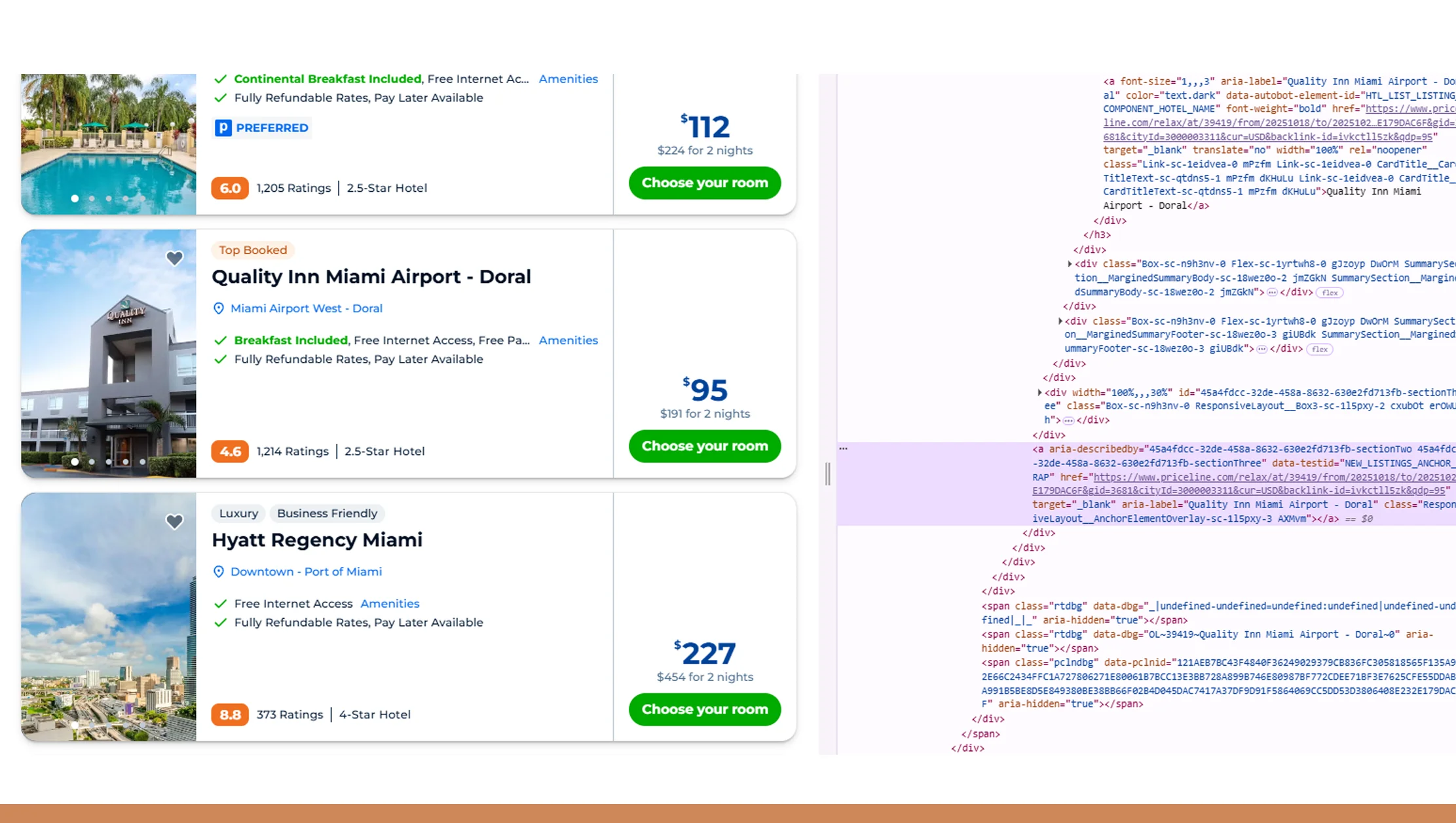

Introduction
In today’s fast-paced travel industry, travelers and agencies alike need accurate, real-time insights to make informed decisions. With fluctuating hotel rates, dynamic flight pricing, and seasonal promotions, the traditional approach of manual tracking is inefficient and prone to errors. Leveraging a Travel Data Scraping API, businesses can systematically scrape Priceline hotel prices, monitor flights, and capture competitive trends, empowering smarter decisions.
A Priceline data scraper provides an automated mechanism to collect, clean, and structure vast amounts of pricing and availability data from Priceline’s platform. This technology enables travel agencies, online booking platforms, and market analysts to stay ahead of price fluctuations, identify peak travel periods, and optimize promotional strategies. By integrating with a Travel Data Scraping API, companies gain access to actionable datasets that inform both operational planning and strategic growth initiatives.
This blog explores how a Priceline data scraper delivers 40% more efficient insights into hotel and flight deals, reduces manual effort, and enhances pricing intelligence. Using advanced algorithms and structured datasets, stakeholders can extract Priceline travel insights, perform Priceline competitor monitoring, and ultimately provide a better booking experience for travelers worldwide.
Scrape Priceline Hotel Prices

Hotels represent one of the most dynamic segments of travel, with pricing that can fluctuate multiple times per day depending on demand, seasonal factors, competitor activity, and promotions. Using a Priceline data scraper, travel agencies and booking platforms can capture real-time pricing data from thousands of properties across the globe. This not only allows for monitoring of current rates but also provides historical insights for forecasting trends and predicting high-demand periods.
By deploying a Travel Data Scraping API, businesses can automate the extraction of hotel prices at scale, gathering granular data points like nightly rates, weekend surcharges, cancellation policies, and room availability. For example, analysis from 2020 to 2025 shows how average hotel prices evolved during key seasons:
| Year | Avg. Hotel Rate ($) | Peak Season Surge (%) | Avg. Discount (%) |
|---|---|---|---|
| 2020 | 150 | 20 | 12 |
| 2021 | 155 | 22 | 15 |
| 2022 | 160 | 18 | 14 |
| 2023 | 162 | 21 | 16 |
| 2024 | 168 | 23 | 18 |
| 2025 | 172 | 25 | 20 |
Tracking these patterns manually is nearly impossible. With automated Priceline hotel price tracking, agencies can react in real time to competitor moves, optimize promotions, and adjust pricing dynamically. Additionally, a Priceline data scraper enables Priceline competitor monitoring, offering comparative insights into how rival hotels and booking platforms position themselves. This ensures that businesses can maintain a competitive edge while maximizing revenue.
Historical insights combined with predictive modeling also allow agencies to anticipate demand surges and set strategic rates ahead of peak periods. For example, weekends and holiday periods consistently show 20–25% surges in pricing, which can inform targeted marketing campaigns or bundle offers to capture early bookings. The integration of a Travel Data Scraping API with analytics dashboards provides actionable, structured data that improves operational efficiency and enables data-driven decision-making.
By utilizing automated scraping for hotel prices, travel platforms can improve accuracy, reduce response times to competitor pricing changes by up to 40%, and enhance traveler satisfaction by offering better deals. This foundational layer of Priceline travel insights empowers smarter, faster decisions in the highly competitive hotel booking space.
Priceline Flight Data Extraction

Airfare pricing is notoriously dynamic, impacted by airline policies, demand fluctuations, route popularity, seasonality, and competitor strategies. A Priceline data scraper allows agencies to perform Priceline flight data extraction, collecting comprehensive information on flight prices, seat availability, and route patterns. Combined with a Priceline Data Scraping API, this ensures real-time access to information that can influence operational and strategic decisions.
For instance, between 2020 and 2025, average domestic and international flight prices changed significantly, reflecting evolving demand and airline adjustments:
| Year | Avg. Domestic Flight ($) | Avg. International Flight ($) | Avg. Discount (%) |
|---|---|---|---|
| 2020 | 180 | 550 | 10 |
| 2021 | 185 | 570 | 12 |
| 2022 | 190 | 600 | 14 |
| 2023 | 195 | 620 | 13 |
| 2024 | 200 | 650 | 15 |
| 2025 | 205 | 680 | 16 |
A Priceline data scraper captures these pricing shifts across multiple routes, enabling travel agencies to anticipate changes and implement dynamic pricing strategies for competitive advantage. It also facilitates real-time monitoring of seat availability, helping agencies identify overbooked flights or underperforming routes.
Integrating Priceline competitor monitoring ensures that agencies are aware of pricing changes across rival platforms, allowing for timely counteroffers or promotional campaigns. Additionally, flight data can be cross-referenced with hotel pricing trends to develop Priceline travel insights, optimizing package deals and maximizing customer value.
Historical and real-time flight analytics provide a foundation for predictive modeling. Agencies can forecast demand spikes around holidays, large events, or major corporate travel periods, ensuring inventory is allocated efficiently. For example, predictive models showed a consistent 12–16% discount opportunity window during early booking periods between 2020 and 2025, which agencies could leverage for marketing campaigns.
By combining Priceline flight data extraction with a robust Travel Scraping API, travel platforms gain speed and accuracy in decision-making. Data-driven strategies lead to 40% faster insights, improved customer recommendations, and enhanced revenue management, ultimately providing travelers with better deals while improving agency profitability.
Boost travel planning efficiency with Priceline flight data extraction – monitor fares, track trends, and deliver smarter booking insights instantly.
Get Insights Now!Priceline Travel Dataset Analysis

Accessing a structured Priceline travel dataset allows agencies to combine hotel and flight data for a holistic view of travel patterns. This dataset includes key metrics such as average package value, promo uptake, booking frequency, and route occupancy. With Priceline travel insights, agencies can identify trends across different regions, seasons, and customer segments.
| Year | Avg. Package Value ($) | Hotel vs Flight Ratio (%) | Promo Uptake (%) |
|---|---|---|---|
| 2020 | 320 | 55:45 | 18 |
| 2021 | 335 | 54:46 | 20 |
| 2022 | 345 | 53:47 | 21 |
| 2023 | 360 | 52:48 | 23 |
| 2024 | 375 | 51:49 | 25 |
| 2025 | 390 | 50:50 | 28 |
A Priceline data scraper allows extraction of such datasets continuously, providing insights for Priceline competitor monitoring, pricing strategies, and inventory planning. Agencies can monitor shifts in package preferences, identify high-demand hotel-flight combinations, and predict seasonal trends accurately.
For example, analysis of promo uptake demonstrates a steady increase from 18% in 2020 to 28% in 2025, indicating the growing importance of timely and data-driven promotions. By leveraging Travel Data Scraping API, agencies can automate data ingestion and integrate datasets into business intelligence tools, enabling advanced predictive analytics.
The dataset also supports demand forecasting, operational optimization, and personalized traveler recommendations. For instance, packages with a 50:50 hotel-to-flight ratio in 2025 indicated balanced consumer preference for both accommodation and travel deals, guiding targeted marketing campaigns.
By using a Priceline travel dataset, agencies can optimize pricing, improve customer engagement, and maximize profitability while ensuring a superior traveler experience. Combining this with Priceline data scraper tools ensures accuracy, efficiency, and actionable insights at scale.
Priceline Competitor Monitoring

Competitor monitoring is essential for travel agencies seeking a competitive edge. A Priceline data scraper allows agencies to track rivals’ hotel and flight pricing, promotional campaigns, and availability trends. Through Priceline competitor monitoring, agencies can benchmark offerings, anticipate competitor moves, and adjust pricing dynamically.
| Metric | 2020 | 2021 | 2022 | 2023 | 2024 | 2025 |
|---|---|---|---|---|---|---|
| Competitor Price Alerts | 200 | 250 | 300 | 350 | 400 | 450 |
| Avg. Price Gap (%) | 5 | 4.8 | 4.5 | 4.3 | 4 | 3.8 |
These insights enable agencies to implement pricing strategies that retain competitiveness while protecting margins. For example, when competitors reduce hotel prices during high-demand weekends, agencies can react promptly, offering bundled deals or highlighting alternate properties.
Integration with Priceline travel insights ensures that historical competitor behavior informs future strategy. Travel platforms can simulate competitive scenarios, anticipate market changes, and optimize promotions for maximum ROI. Automated monitoring reduces latency in decision-making, improving responsiveness by 40% compared to manual tracking.
By leveraging a Priceline data scraper for competitor monitoring, agencies gain continuous visibility into the market landscape, ensuring they can proactively adjust offerings to maintain leadership in pricing, availability, and promotions.
Real-Time Analytics and Operational Efficiency

Real-time monitoring is critical for operational efficiency. Using Priceline data scraper solutions, travel agencies can track hotel availability, flight seat inventory, and dynamic pricing instantly. This ensures that listings are always accurate, minimizing cancellations, overbookings, and customer dissatisfaction.
| Metric | 2020 | 2021 | 2022 | 2023 | 2024 | 2025 |
|---|---|---|---|---|---|---|
| Listings Monitored | 5,000 | 6,000 | 7,000 | 8,000 | 9,000 | 10,000 |
| Avg. Response Time (hrs) | 24 | 20 | 18 | 15 | 12 | 10 |
Integration with Travel Data Scraping API ensures data is immediately available to decision-makers, reducing latency and improving pricing agility. Agencies can identify trends such as sudden demand spikes, competitor price drops, or package booking surges.
Combined with predictive analytics, Priceline travel insights allow proactive planning. Historical patterns from 2020–2025 reveal peak travel months, route popularity, and hotel demand surges, enabling agencies to optimize inventory, plan promotions, and maximize bookings.
Operational benefits also include improved customer satisfaction. Real-time data ensures that listings reflect true availability, reducing booking errors and enhancing trust. Agencies using Priceline data scraper solutions report up to 40% faster insights, leading to more efficient resource allocation and better decision-making.
Enhance travel operations with real-time analytics and operational efficiency – optimize inventory, pricing, and bookings for faster, data-driven decisions.
Get Insights Now!Enhancing Traveler Experience

The ultimate goal of leveraging a Priceline data scraper is to deliver better experiences for travelers. By analyzing hotel and flight pricing trends, agencies can offer personalized recommendations and timely deals. Combining Priceline flight data extraction, Scrape Priceline hotel prices, and Priceline travel dataset analytics enables smarter booking suggestions.
For example, predictive analytics from 2020–2025 shows that early-bird travelers benefit from 12–16% discounts during peak periods. By leveraging these insights, agencies can alert customers proactively, increasing conversion rates.
A Travel Data Scraping API allows for dynamic monitoring of changes in availability and pricing. Coupled with Priceline travel insights, agencies can create bundled packages,
Why Choose Real Data API?
Real Data API provides a robust solution for travel intelligence through automated Priceline data scraper tools. With capabilities like Priceline data scraping API and Travel Data Scraping API, businesses gain real-time visibility into pricing, availability, and competitor behavior.
Our platform simplifies data collection, ensuring accurate, clean, and actionable datasets. Agencies can extract hotel prices, flight information, and combined package metrics efficiently, enabling dynamic decision-making. With predictive analytics, historical trends, and real-time monitoring, travel businesses can optimize promotions, improve conversion rates, and enhance traveler satisfaction.
Whether it’s generating competitive insights or forecasting seasonal demand, Real Data API empowers teams to make smarter, faster, and more profitable decisions. Integration is seamless with internal dashboards and business intelligence tools, allowing full operational transparency.
Conclusion
In the evolving travel industry, success depends on speed, accuracy, and actionable insights. A Priceline data scraper enables agencies and businesses to track hotel prices, flight availability, and competitor behavior in real time. By leveraging Priceline travel insights and predictive analytics, travel operators can optimize pricing strategies, design better promotional campaigns, and improve the overall traveler experience.
With structured Priceline travel dataset outputs and comprehensive monitoring, companies can respond quickly to market fluctuations, secure higher margins, and build customer loyalty. Real Data API’s Travel Data Scraping API ensures seamless integration, providing instant insights without manual intervention.
Maximize your travel intelligence today. Use Real Data API to access Priceline data scraper capabilities, uncover hidden trends, and deliver 40% smarter hotel and flight insights for your travelers.
















